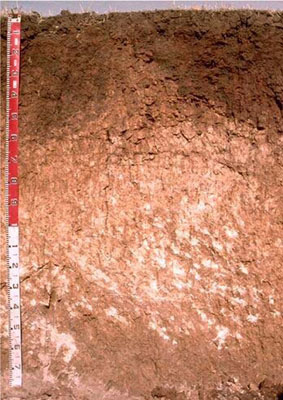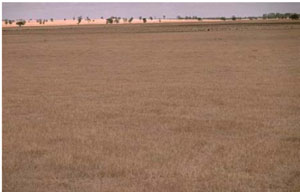LSWW04a
|  Epicalcareous-Endohypesodic, Epipedal, Red VERTOSOL | |||
|
Location | Lillimur, western Victoria | |||
|
Landform | Rise | |||
|
Geology | Quaternary Woorinen Formation: aeolian dune sand, calcareous clay | |||
|
Element | Hillslope | |||
Horizon | Depth (cm) | Description | ||
A1 | 0–10 | Dark brown (10YR3/3); light medium clay; moderate fine subangular blocky to polyhedral structure; very firm consistence when dry; very few ferruginous nodules; pH 8.1; abrupt boundary to: | ||
B21 | 10–50 | Yellowish red (5YR5/8;) medium clay(increasing to medium heavy clay at depth); strong angular coarse blocky, parting to medium blocky structure; smooth ped fabric; a few slickenside cutans; strong consistence when slightly moist; few ferruginous nodules; pH 8.7; clear and wavy boundary to: | ||
B22k | 50–80 | Reddish yellow (7.5YR7/6); light medium clay; moderate coarse prismatic, parting to strong coarse subangular blocky and moderate medium blocky structure; smooth ped fabric; very firm consistence when slightly moist; many soft calcareous segregations; pH 9.7; gradual and wavy boundary to: | ||
B23k | 80–130 | Reddish yellow (7.5YR6/6), with few fine mottles; light medium clay; strong coarse prismatic structure (at depth) to moderate coarse lenticular structure; smooth ped fabric, firm consistence when moderately moist; contains many (although patchy) soft calcareous segregations; pH 9.7; gradual and wavy transition to: | ||
B24 | 130–180+ | Reddish yellow (7.5YR6/6), with very few fine faint light grey mottles; medium clay; strong coarse lenticular, parting to fine lenticular structure; smooth ped fabric; strong consistence when slightly moist; very few soft calcareous segregations; pH 9.6. | ||
| Management Considerations | ||||
| ||||
Horizon | Depth (cm) | pH (water) | pH (CaCl2) | EC dS/m | NaCl % | Exchangeable Cations cmol-/kg | Wilting Point (pF4.2) | Coarse Sand % | Fine Sand % | Silt % | Clay % | |||
Ca | Mg | K | Na | |||||||||||
A1 | 0–10 | 8.1 | 7.5 | 0.15 | 19 | 2.3 | 1.9 | 0.3 | 13.6 | 16 | 38 | 9 | 29.5 | |
B21 | 10–50 | 8.7 | 8 | 0.14 | 23 | 8.8 | 1.3 | 1.4 | 26.9 | 8.8 | 18.8 | 6 | 56.5 | |
B22k | 50–80 | 9.7 | 8.5 | 0.41 | <0.05 | 6.2 | 11 | 1 | 6 | 22.0 | 4.8 | 10.8 | 5.5 | 35 |
B23k | 80–130 | 9.7 | 9 | 0.6 | <0.05 | 4.2 | 11 | 1.1 | 9.4 | |||||
B24 | 130–180+ | 9.6 | 8.8 | 0.63 | <0.05 | |||||||||



